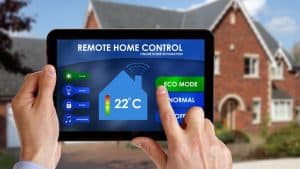HEM
 Home Energy Management (HEM) refers to technologies that help homeowners improve home energy efficiency by giving them remote access to manage household appliances, including HVAC; from tablets, smartphones, and computers.
Home Energy Management (HEM) refers to technologies that help homeowners improve home energy efficiency by giving them remote access to manage household appliances, including HVAC; from tablets, smartphones, and computers.
HEM systems save people on energy consumption (thus money) and time. With wi-fi enabled remote control access via a home energy management system - one can control thermostats, lights, smart outlets, power strips, and other appliances or home monitors.
What can HEM do?
HEM systems include smart thermostats, smart appliances that regulate energy consumption, smart outlets, and smart plug strips that turn completely off when not in use. An increasingly common addition to HEM systems are home monitors, including ones that provide home security systems.
Home energy management systems can remotely allow you to monitor and adjust your home appliances via an app on your smart phone, tablet, or on a unique portable wi-fi enabled HEM device. HEM can operate and function with your lights, HVAC, air conditioners, refrigerators, pool pumps, water heaters, and dryers and washing machines; however, the product that best exemplifies HEM is the programmable thermostat.
Smart appliances that can connect to HEM systems
Smart appliances and monitors (notable examples include smart thermostats, smart outlets connected to lighting and electronics, and security systems) can connect with a wi-fi enabled HEM systems. Of the smart thermostats, the Nest programmable thermostat (the pioneer of this technology, introduced to the mass market in 2011), continues to be the most popular brand. The Nest makes it simple to change the temperature of your home from your computer, mobile device or tablet. Another popular and innovative smart product, the Ecobee3, is an example of a smart thermostat that offers an additional unique feature. With the Ecobee3, thermostats can be programmed to control the temperature in up to 32 rooms (with additional sensors). If the temperature in a multistory home varies from room to room due to a standard HVAC, the Ecobee3 offers a solution. These are two examples of user-friendly smart thermostats.
Another HEM product is the smart outlet. With the smart outlet, the power of any home appliance can be measured. Through a tablet, smartphone, or PC, the outlets can also be used to set schedules for lights or electronics. The schedules can be coordinated with the grid to have a reduction in energy consumption during peak energy production hours, if the utility offers such data. Smart appliances (like a smart washer/ dryer) can reduce their energy consumption during peak hours as well. The latest in HEM offerings are complete home monitoring systems with home alarm and security systems, combined with remote controlled lighting, as well as host of other HEM energy efficiency systems.
Today, service providers, and home security providers, other than utilities, are at the forefront in the smart grid, in part due to smart energy efficiency systems like HEM products. Companies that provide home alarm, cable, internet, and even some smart phone service providers, are now adding energy monitoring, control, and optimization services to their offerings; pushing utilities into a supporting role. However, utilities and service providers are both still experimenting with different approaches to HEM. The cable service provider, and home security company, are promising alternatives to utilities as far as extending the innovations of the smart grid into more homes; and to increase the adoption of HEM in homes and buildings. Dominantly, the consumers making adoption of HEM systems widespread are individual households and businesses purchasing HEM systems for homes, commercial buildings, and small businesses. Along with implementation of HEM systems, are also use of the many various smart appliances and monitors that go hand-in-hand with HEM systems.
please also see:
Smart Grid - a more energy efficient use of utilities